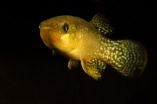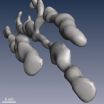(Press-News.org) BATON ROUGE – LSU's Mark Batzer, LSU Boyd Professor and Dr. Mary Lou Applewhite Distinguished Professor, along with Research Assistant Professor Miriam Konkel and Research Associate Jerilyn Walker in Department of Biological Sciences in the College of Science, contributed to an article featured on the cover of the scientific journal Nature, titled "Gibbon Genome and the Fast Karyotype Evolution of Small Apes."
An abstract of the article can be found at http://www.nature.com/nature/journal/v513/n7517/full/nature13679.html?WT.ec_id=NATURE-20140911. The issue of Nature will be published on Sept. 11.
Batzer, Konkel and Walker contributed to the analysis of the mobile elements in the gibbon genome. This included the characterization of the mobile genetic element called LAVA.
LAVA is made up of pieces of known jumping genes and named after its main components: L1, Alu, and the VA section of SVA mobile elements. The gibbon-specific LAVA element represents only the second type of composite mobile element discovered in primates, since the discovery of the mobile element SVA in humans.
The sequencing, assembly and analysis of the gibbon genome provide new insights into the biology and evolutionary history of this family of apes. Factors that might have contributed to gibbon diversity and that might have helped gibbons to adapt to their jungle habitat are reported.
As part of the gibbon genome project, Batzer analyzed the evolution of gibbon-specific mobile elements, including their subfamily structure and distribution among the various gibbon species. The discovery of LAVA further highlights the dynamic evolution of mobile elements and their dynamic impact on primate genomes.
Gibbons are small, tree-living apes from Southeast Asia, many species of which are endangered. They are part of the same superfamily as humans and great apes, but sit on the divide between Old-World monkeys and the great apes. These creatures have several distinctive traits, such as an unusually large number of chromosomal rearrangements, and different numbers of chromosomes are seen in individual species.
Batzer runs the Batzer Laboratory of Comparative Genomics in the LSU College of Science, which specializes in the study of mobile DNA elements, often called "jumping genes" or even "junk DNA." These mobile elements have been found to cause insertions and deletions, which can lead to genetic diseases in humans as well as the creation of new genes and gene families in the genome. Because of this, understanding the impact of mobile elements on genome structure is paramount to understanding the function of the genome.
INFORMATION:
More information on the Batzer Lab is available at https://biosci-batzerlab.biology.lsu.edu/.
The LSU College of Science is the place where science, research and innovation intersect to create an enriching academic experience that prepares students for rewarding careers in education, medicine, research, business or public service. The college houses a variety of scientific disciplines supported by a community of accomplished and well-funded faculty and staff that are committed to providing a meaningful educational experience. For more information on the LSU College of Science, visit http://science.lsu.edu/.
Gibbon genome and the fast karyotype evolution of small apes
LSU's Batzer, Konkel and Walker contribute to Nature cover article on small-ape evolution
2014-09-10
ELSE PRESS RELEASES FROM THIS DATE:
NASA sees a significant flare surge off the sun
2014-09-10
The sun emitted a significant solar flare, peaking at 1:48 p.m. EDT on Sept. 10, 2014. NASA's Solar Dynamics Observatory captured images of the event.
Solar flares are powerful bursts of radiation. Harmful radiation from a flare cannot pass through Earth's atmosphere to physically affect humans on the ground. However -- when intense enough -- they can disturb the atmosphere in the layer where GPS and communications signals travel.
To see how this event may affect Earth, please visit NOAA's Space Weather Prediction Center at http://spaceweather.gov, the U.S. government's ...
Study provides more evidence that sleep apnea is hurting your brain
2014-09-10
Employing a measure rarely used in sleep apnea studies, researchers at the UCLA School of Nursing have uncovered evidence of what may be damaging the brain in people with the sleep disorder — weaker brain blood flow.
In the study, published Aug. 28 in the peer-reviewed journal PLOS ONE, researchers measured blood flow in the brain using a non-invasive MRI procedure: the global blood volume and oxygen dependent (BOLD) signal. This method is usually used to observe brain activity. Because previous research showed that poor regulation of blood in the brain might be a problem ...
Sharks more abundant on healthy coral reefs
2014-09-10
Sharks in no-fishing zones in the Great Barrier Reef (GBR) Marine Park are more abundant when the coral is healthy, according to a study published September 10, 2014 in the open-access journal PLOS ONE by Mario Espinoza from James Cook University, Australia and colleagues.
Shark species that use coral reefs may be under pressure from fishing, habitat degradation, and climate change. The authors of this study were interested in understanding the factors that affect the distribution and abundance of shark populations in the GBR, including fishing and habitat quality. To ...
Gulf killifishes' biological responses to oil spills similar in field, laboratory studies
2014-09-10
Gulf killifish biological responses to the Deepwater Horizon oil spill detected by researchers in the field are similar to those in controlled laboratory studies, according to a study published September 10, 2014 in the open-access journal PLOS ONE by Whitney Pilcher from Louisiana State University and colleagues.
After the Deepwater Horizon oil spill, scientists monitored the impacts of oil on a local species of fish, the Gulf killifish. Changes in genome expression responses to oil exposure may provide insight into how the fish are affected by or adapt to environmental ...
New study shows impact of movies on dog breed popularity
2014-09-10
The effect of movies featuring dogs on the popularity of dog breeds can last up to ten years and is correlated with the general success of the movies, according to new research from the University of Bristol, the City University of New York, and Western Carolina University.
The study, published today in PLOS ONE, also found that movies' influence was strongest in the early twentieth century and has declined since.
The researchers used data from the American Kennel Club, which maintains the world's largest dog registry totalling over 65 million dogs, and analysed a total ...
New 3-D imaging techniques may improve understanding of biofuel plant material
2014-09-10
Comparison of 3D TEM imaging techniques reveals never-seen-before details of plant cell walls, according to a study published September 10, 2014 in the open-access journal PLOS ONE by Purbasha Sarkar from University of California, Berkeley and colleagues.
Cost-effective production of plant material for biofuel requires efficient breakdown of plant cell wall tissue to retrieve the complex sugars in the cell wall required for fermentation and production of biofuels. In-depth knowledge of plant cell wall composition is therefore essential for improving the fuel production ...
New study examines impact of violent media on the brain
2014-09-10
(NEW YORK – September 10, 2014) With the longstanding debate over whether violent movies cause real world violence as a backstop, a study published today in PLOS One found that each person's reaction to violent images depends on that individual's brain circuitry, and on how aggressive they were to begin with.
The study, which was led by researchers at the Icahn School of Medicine at Mount Sinai and the NIH Intramural Program, featured brain scans which revealed that both watching and not watching violent images caused different brain activity in people with different ...
Study ties groundwater to human evolution
2014-09-10
Our ancient ancestors' ability to move around and find new sources of groundwater during extremely dry periods in Africa millions of years ago may have been key to their survival and the evolution of the human species, a new study shows.
The research – published in the journal PLOS ONE – combines geological evidence from the Olduvai sedimentary basin in Northern Tanzania, which formed about 2.2 million years ago, and results from a hydrological model.
It shows that while water in rivers and lakes would have disappeared as the climate changed due to variations in the ...
Is spooning really the best position for men with back pain?
2014-09-10
September 10, 2014 – A study using motion capture technology provides new information on the spinal strain produced by various sexual positions—suggesting that one position commonly recommended for all men with low back pain is not actually the best choice, reports a study in the journal Spine. The journal is published by Lippincott Williams & Wilkins, a part of Wolters Kluwer Health.
The results provide a more scientific basis for making individualized recommendations regarding sexual positions for men with low back pain, according to Natalie Sidorkewicz, MSc, and Stuart ...
Seismic gap may be filled by an earthquake near Istanbul
2014-09-10
When a segment of a major fault line goes quiet, it can mean one of two things: The "seismic gap" may simply be inactive — the result of two tectonic plates placidly gliding past each other — or the segment may be a source of potential earthquakes, quietly building tension over decades until an inevitable seismic release.
Researchers from MIT and Turkey have found evidence for both types of behavior on different segments of the North Anatolian Fault — one of the most energetic earthquake zones in the world. The fault, similar in scale to California's San Andreas Fault, ...
LAST 30 PRESS RELEASES:
Heart-brain connection: international study reveals the role of the vagus nerve in keeping the heart young
Researchers identify Rb1 as a predictive biomarker for a new therapeutic strategy in some breast cancers
Survey reveals ethical gaps slowing AI adoption in pediatric surgery
Stimulant ADHD medications work differently than thought
AI overestimates how smart people are, according to HSE economists
HSE researchers create genome-wide map of quadruplexes
Scientists boost cell "powerhouses" to burn more calories
Automatic label checking: The missing step in making reliable medical AI
Low daily alcohol intake linked to 50% heightened mouth cancer risk in India
American Meteorological Society announces Rick Spinrad as 2026 President-Elect
Biomass-based carbon capture spotlighted in newly released global climate webinar recording
Illuminating invisible nano pollutants: advanced bioimaging tracks the full journey of emerging nanoscale contaminants in living systems
How does age affect recovery from spinal cord injury?
Novel AI tool offers prognosis for patients with head and neck cancer
Fathers’ microplastic exposure tied to their children’s metabolic problems
Research validates laboratory model for studying high-grade serous ovarian cancer
SIR 2026 delivers transformative breakthroughs in minimally invasive medicine to improve patient care
Stem Cell Reports most downloaded papers of 2025 highlight the breadth and impact of stem cell research
Oxford-led study estimates NHS spends around 3% of its primary and secondary care budget on the health impacts of heat and cold in England
A researcher’s long quest leads to a smart composite breakthrough
Urban wild bees act as “microbial sensors” of city health.
New study finds where you live affects recovery after a hip fracture
Forecasting the impact of fully automated vehicle adoption on US road traffic injuries
Alcohol-related hospitalizations from 2016 to 2022
Semaglutide and hospitalizations in patients with obesity and established cardiovascular disease
Researchers ‘listen in’ to embryo-mother interactions during implantation using a culture system replicating the womb lining
How changing your diet could help save the world
How to make AI truly scalable and reliable for real-time traffic assignment?
Beyond fragmented markets: A new framework for efficient and stable ride-pooling
Can shape priors make road perception more reliable for autonomous driving?
[Press-News.org] Gibbon genome and the fast karyotype evolution of small apesLSU's Batzer, Konkel and Walker contribute to Nature cover article on small-ape evolution


